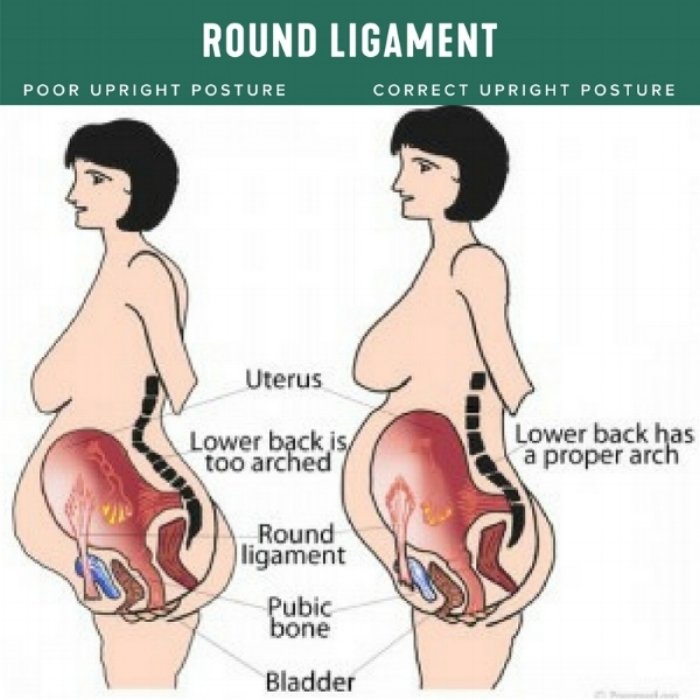Treating Round Ligament Pain in Pregnancy
What is round ligament pain?
Round ligament pain is a sharp, stabbing pain on one or both sides of your abdominals. It usually happens during the second half of pregnancy — and it can make daily movement feel unbearable.
Typically, people feel round ligament pain most during transitional activities, like when you’re shifting from sitting to standing or rolling over in bed.
Fortunately, there are things you can do to help relieve the pain. We often recommend avoiding or modifying the activities that trigger your round ligament pain and strengthening the muscles you need for proper posture.
Here’s what you need to know about round ligament pain, including what causes it and how to alleviate the pain.
What causes round ligament pain?
We actually have two round ligaments — one to support each side of the uterus. They originate on the lateral side of the uterine horns (where your fallopian tubes attach) and exit the pelvis near your groin.
During the later stages of pregnancy, these ligaments get really stretched and have to accommodate the extra load placed on them as your baby increases in size.
Sudden movements like standing up quickly, rolling over in bed, coughing, sneezing or laughing can cause the round ligament to tighten and cause pain.
Round ligament pain treatment
Go into protective mode
A huge part of relieving round ligament pain is avoiding a rapid stretch of the ligament.
To avoid that stretch, you’ll need to slow down transitional movements (like getting out of the car, standing up or rolling over in bed) and learn to contract your transverse abdominals:
Contracting your transverse abdominals. The best cue to engage your transverse abdominals is to tuck your tailbone up and in towards your belt line or think about bringing your “ribs to your hips” (this is NOT simply sucking your stomach in).
Standing up. When standing up, you want to start by scooting to the edge of the chair. Then put your nose over your toes and use your quads to stand up.
Getting in and out of bed. Use the log rolling technique when getting in and out of bed.
Coughing or sneezing. If you need to cough or sneeze, bend your knees toward your chest to take the tension off the round ligament.
It’s also important to breathe during all movement. Inhale, exhale, then move!
Start walking
Get moving! Walking is one of the best things you can do for round ligament pain. Take deep breaths using your diaphragm as you walk. This helps to loosen up some of the tension on the abdominal cavity and the tissues — including the round ligament. The body and tissues LOVE movement to keep them from sticking to one another.
Try self massage
Massage — working from the outside of your hip bone towards the pubic bone (right above the clitoris) — can help create movement in that area.
Practice good body mechanics
During pregnancy, two postural changes often happen that add more stress on the round ligaments:
1. As your baby bump grows, you lean back your upper body to allow more room for growing baby (ribs flare).
2. Your low back has more of a sway to it, allowing our pelvis to dump forward (anterior pelvic tilt).
These posture changes make it difficult for your core to function properly. Learning to stack your ribs over your hips allows for automatic core engagement, taking pressure off of the round ligaments.
Here's the fix:
Cue good posture throughout the day:
Think about getting tall as if someone is pulling your high ponytail upward.
Drop the front of your ribs downward.
Work on not pushing your bump out by tucking your pelvis into a more neutral position.
Do pelvic clocks:
In this exercise, your pelvis is like a clock. Start in a quadruped position — 12 o’clock is up, 6 o’clock is toward your feet.
Move from 12 to 6 (flatting and arching your lower back).
If you feel stuck, this is something you want to do often.
Gain strength to support your growing bump
If you don’t have the right muscular support to hold up your growing bump, you’re more likely to rely on muscles like your round ligaments to support you (aka you're more likely to develop poor posture during pregnancy) — so it’s important to do the right exercises to build that strength.
This can be really hard to achieve during pregnancy because we’re constantly fighting gravity while losing muscle mass and strength.
Exercises used in our Pregnancy Guide in our Expecting and Empowered App are designed to relieve round ligament pain:
Products that will help with round ligament pain
Giving the round ligament a bit of assistance can be very helpful to support your bump and reduce tension.
When to contact your physician
Although round ligament pain is a common and harmless pregnancy condition, abdominal pain can be a sign of a serious problem, such as preterm labor, severe preeclampsia, placental abruption, or a medical problem unrelated to pregnancy like appendicitis.
Typically round ligament pain gets better when your knees are bent toward your chest and is worse with transitional movements. These other issues are not made better or worse with changes in position. Contact your physician if you experience that type of pain.
Need more help?


